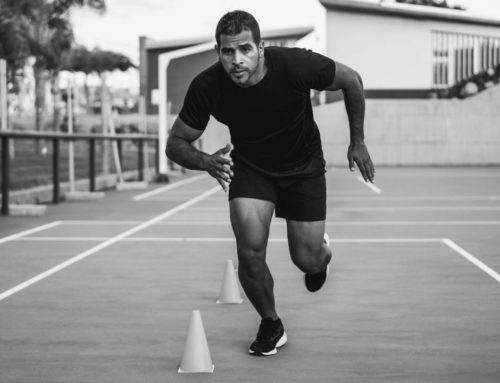Strength training inadvertently increases tendon strength, but by targeting tendons specifically, you can create a stronger chain without weaknesses to smash personal bests and plateaus. It’s not all smooth sailing, though. The tendons are a notoriously low blood supply area, which means that they don’t recover or get stronger as quickly as you may be gaining strength. This can lead to pain and tendonitis of the elbow. Luckily, there are some elbow tendonitis exercises that can fix your sad elbows.
Types of elbow tendonitis
The two types of tendonitis in the elbow are tennis and golfers elbow and no, you don’t need to play either sport to own their unfortunate elbows.
The difference between the two is where the pain and inflammation of your elbows is occurring. Tennis elbow affects the lateral, or outside, epicondyle and golfer’s elbow affects the medial, or inner, elbow. Simple, right? Pain on the outside means tennis elbow. Pain on the inside elbow means golfers.
Elbow tendonitis exercises to fix your elbows in two steps
There are two steps to regaining the health of your elbows and getting you back into the game.
1. Pain relief and fixing the problem
2. Strengthening tendons so the injury doesn’t reoccur
Step 1: elbow tendonitis stretches
For pain relief, let’s look at what we can do to reduce inflammation and get the tendonitis under control. Much of tendonitis will be an overuse issue, so resting will be and important part of the plan – yeah, I know, you’re hardcore and are ‘Mr No Day’s Off’. Let me know how hardcore you look when it’s too painful to even curl those pink 2.5lb dumbbells.
Besides resting, there are some stretches that will help with both golfers and tennis elbow:
Wrist flexion and extension
Without using your other hand for assistance, bend the wrist of your injured arm forward and back as far as you can for 2 sets of 15 – 20.

Wrist stretch
This time using the spare hand, press the back of the hand on your injured side to help bend your wrist. Hold for 15 to 45 seconds. Then, stretch the hand back by pressing the fingers in the other direction. Hold for 15 to 45 seconds. Keep the arm on your injured side straight during this exercise. Do this for 2 or 3 sets.

Forearm palm rotation
Keeping your elbow tucked into your side, bend the injured arm 90 degrees. Turn your palm up and hold it there for 5-10 seconds. Then slowly turn your palm down to the floor and hold for another 5-10 seconds. Make sure you keep your elbow at your side and bent 90 degrees while you do the exercise. Do 2-3 sets of 15-20.

Step 2: strengthening elbow tendonitis exercises
This involves isometric training with elbow tendonitis exercises, where the joint angle and muscle length don’t change during contraction, unlike a dynamic movement’s concentric or eccentric contractions.
There are two main methods of isometric training: isometric hold and isometric press/pull. Stephen Kirlew, trainer and former world champion arm wrestler takes you through his workout to build tendons of steel.
Isometric hold
An isometric hold is a static exercise in which a person holds a particular position for a period of time with resistance. An example of this is holding your bicep static on a preacher bench.
Isometric press/pull
An isometric press is a static elbow tendonitis exercise in which a person pushes or pulls against an immovable object for a required time. An example of this is how Bruce Lee would push against a wall in a punching position for 10 seconds.
How to perform isometric elbow tendonitis exercises
Instead of a specific tendon training day, simply add one isometric exercise at the end of each muscle group (so, you’d do one exercise at the end of chest, and one at the end of biceps). This way, you’re only adding an extra 10 minutes to your program, but you’ll reap more rewards by doing so.

Alternate between isometric holds and isometric pushes/pulls (examples right) – one week for holds, and the next for pushes/ pulls. Here’s a typical dynamic arm workout with isometric exercises added into the mix.
Biceps
1. Incline dumbbell curl – 4 sets, 10 reps, 2-0-2-0 tempo.
2. Preacher hammer dumbbell curl – 4 sets, 10 reps, 2-0-2-0 tempo.
3. 21s with barbell (drag curl x 7 reps, half curl from bottom to 90 degrees x 7 reps, full range curl
x 7) – 4 sets, 1-0-1-0 tempo.
4. Dumbbell isometric hold with dynamic curls (holding
the dumbbell at a 90 degree angle) with one arm while dynamic dumbbell curl with
the other arm – 3 sets, 10 reps, 1-0-1-0 tempo.
Triceps
1. Close grip barbell bench press – 4 sets, 10 reps, 2-0-2-0 tempo. 2. Tricep push-down – 4 sets, 10 reps, 2-0-2-0 tempo.
3. Tricep rope overhead extensions – 4 sets, 10 reps, 2-0-2-0 tempo.
4. Isometric dip (hold) – 3 sets, 10 second hold (at 90 degree angle, almost at the bottom of the movement – add weight to a dipping belt if necessary).
Isometric pull/push arm workouts
Biceps
1. Dumbbell hammer curl – 4 sets, 10 reps, 2-0-2-0 tempo.
2. EZ curl – 4 sets, 10 reps, 2-0-2-0 tempo.
3. EZ drag curl – 4 sets, 8 reps, 2-0-2-0 tempo.
4. EZ isometric pull (get a friend to stop the bar at 90 degrees, you then give everything you’ve got to finish off the curl) – 3 sets, 10 seconds per isometric pull.
Triceps
1. Skullcrushers – 4 sets, 10 reps, 2-0-2-0 tempo.
2. Tricep rope pushdown – 4 sets, 10 reps, 2-0-2-0 tempo.
3. Tricep kick-backs (squeeze the tricep at the end of the movement) – 4 sets, 10 reps, 1-0-1-0 tempo.
4. Close grip isometric push-up (with a friend pushing you down from your upper back – you then give it everything you’ve got to push-up) – 3 sets, 10 seconds per isometric push.
Finally, before you curl…
Always ensure you’re warm before training, as tendons have a poor blood supply. Ice after a heavy session will increase blood flow and decrease inflammation. Vitamin C will help the body’s natural production of both collagen and elastin.
For more articles on elbow tendonitis exercises, nutrition tips, interviews and training advice, get TRAIN magazine direct into your inbox every month for free by signing up to our newsletter







